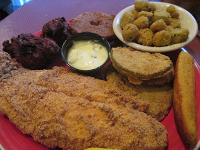First major study of diet and strokes links fried, sugary Southern diet, low on fruits and vegetables, to increased risk

 |
| Genuine Kentucky fried platter: Cornbread, fried catfish, fried green tomatoes, fried apples and fried okra (Photo from Ramsey’s, Lexington) |
By Molly Burchett
Kentucky Health News
People with a Southern diet, or one heavy on fried food and sugary drinks like
sweet tea and soft drinks, are more likely to suffer a stroke, a new study finds.
It’s the first big look at diet and strokes, and researchers say
it might help explain people in the nation’s “stroke belt” or southern
states suffer more of them, reports Marilynn Marchione of The Associated Press.
These findings have important implications for Kentuckians because stroke accounts for 5.5 percent of Kentucky deaths each year and more than 81 percent of Kentucky adults eat fruit and vegetables fewer than 5 times a day, which is a indicator of risk for stroke:
|
Heart Disease and Stroke Risk Factors
from federal Behavioral Risk Factor Surveillance System national survey |
Ky. |
U.S.
|
|---|---|---|
| Eat fruits and vegetables less than 5 times/day | 81.6 | 75.6 |
| Overweight or obese | 69.1 | 62.9 |
| No moderate or vigorous physical activity | 55.8 | 50.5 |
| High total blood cholesterol | 38.5 | 37.6 |
| High blood pressure | 30.0 | 27.8 |
| Cigarette smoking | 28.2 | 19.8 |
| Diabetes | 9.9 | 8.0 |
“We’re talking about fried foods, french fries, hamburgers,
processed meats, hot dogs,” bacon, ham, liver, gizzards and sugary drinks,
said the study’s leader, Suzanne Judd of the University of Alabama in
Birmingham. For the study, a southern diet also included jerky, red meat, eggs, and whole milk.
Fried foods tend to be eaten with lots of salt, which raises blood pressure and sweet drinks increases risk for diabetes- both are known stroke risk factors, Judd said.
People who ate about six meals a week featuring these sorts of
“Southern” foods had a 41 percent higher stroke risk than people who ate that way about
once a month, researchers found.
whole grains and fish had a 29 percent lower stroke risk, reports Marchione.
message for people in the middle is there’s a graded risk” — the
likelihood of suffering a stroke rises in proportion to each Southern meal in a
week.
Stroke death rates in Kentucky vary widely among counties. Here’s a county map of the rates, from KentuckyHealthFacts.org, which has a county-by county list:
The map shows stroke rates in ranges per 100,000 population from 2003 through 2007. Purple counties had rates above 69; blue counties ranged from 52 to 69; turquoise were 44 to 52; light blue were 31 to 44 (the number that is about the national average), and tan were 18 to 31.
